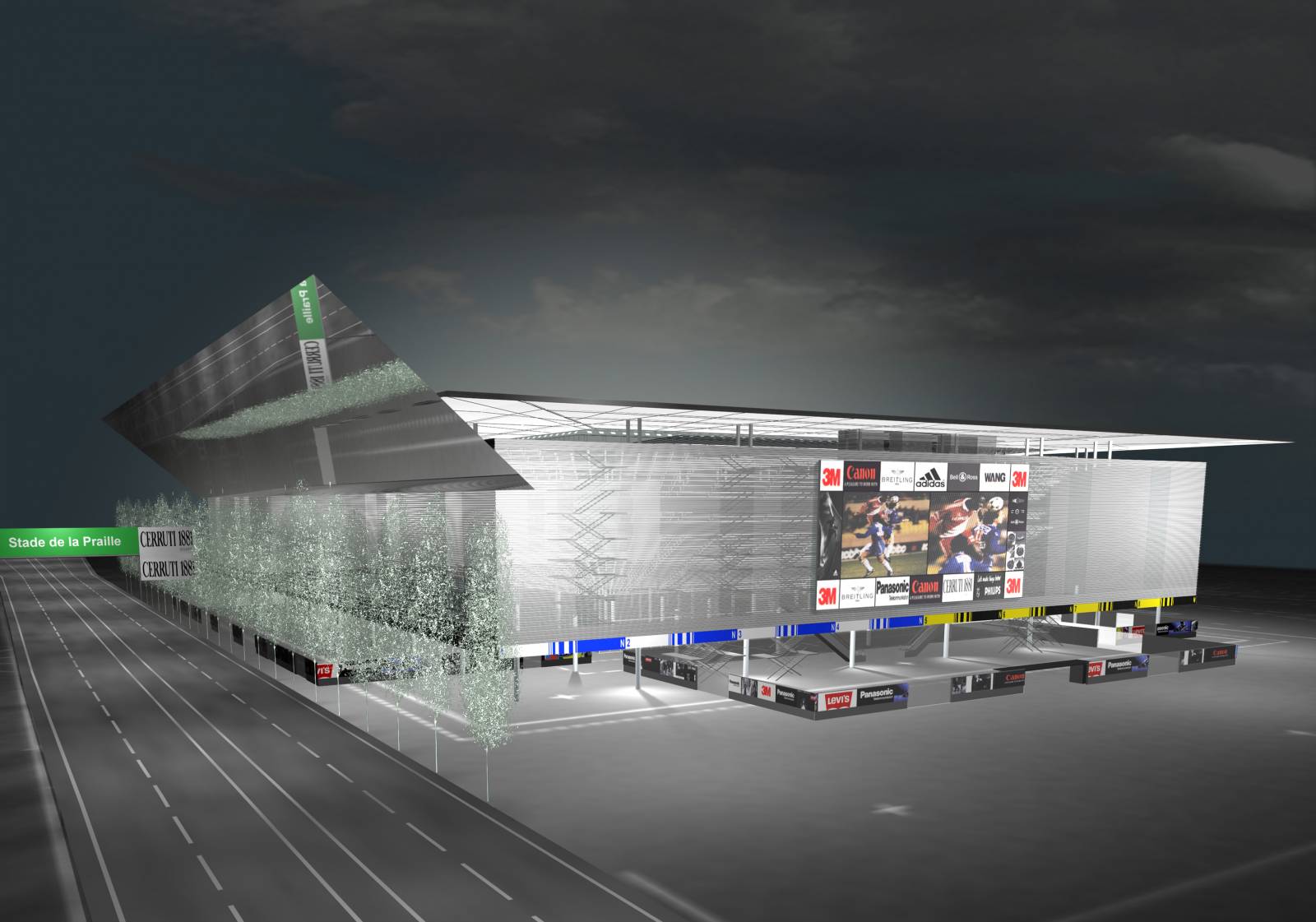Geneva stadium
- Geneva, Switzerland
Spor(t)inox or the Game Machine
Building a stadium these days has to be a symbolic act.
Symbolic of a concern to work out the values of an anxious and too often misunderstood younger generation, for whom sport, music and hooking up are reasons to live.
Symbolic of a concern to upgrade urban spaces that need to be reclaimed.
In this sense, it’s not just about building one more stadium in the ashtray, flying saucer or soup tureen mould. It’s about creating a structure that’s monumental and festive and therefore fun, entertaining, welcoming, like the arenas of the cities of Antiquity. This means ramping up the scale and declaring the town’s pride at having a modern arena: you don’t tuck an arena away, you don’t hide it! The stadium is noble, it shows itself and puts on a show.
It draws on the mythology of sport and, in its modernity, sums up the fabulous esthetics that have emerged from sport over the past few decades… esthetics that draw on the mythology. Footballers and other great athletes should be seen as artists: the peculiarity of artists and of art is to generate sensations and emotions.
So a modern stadium means absolute respect for players and the joys they arouse.
The playing field is sacred, and the lawn – sunny, well-watered, drained and aired – is given every possible care.
But if building a modern stadium is a symbolic act, it’s also an act that’s defined by the standard of efficiency.
The primary efficiency covers sports.
The stadium heads the list of supporters, it has to promote victory. ‘San Siro is the ideal configuration for playing football. No Olympic rings! You can sense your audience, live. It’s a field that’s definitely hostile to your opponents. There’s no way out: the fans are everywhere, in front of you, behind you, to the side. With you…!’ says Gianni Rivera, legendary Italian footballer and parliamentarian.
Within the efficiency model imposed by football, this stadium is rectangular and massive, stands as straight and tall as possible, and is always full.
To secure the loyalty of a large audience in a stadium that can seat 30,000 (30,000 in order to meet the norm for international matches!), it also often has to be a stadium of only 6,000, 10,000 or 20,000 spectators. Thanks to a straightforward capacity-adjustment system, the stadium never looks half-empty: the underside of the stands is lined with an adjustable section with elastic net webbing winders that lock onto the floor of the bleachers.
The second point of efficiency is indissociable from the first: economic efficiency. This translates to the advanced engineering and convenience of the seating system. Our experience designing the Grand Stade de France means we can propose the best of what’s on offer when it comes to joint functions, comfort and flexibility. It’s essential that there be direct elevator access to the stands from the car park located in the infrastructure.
Economic efficiency also extends to the advertising and its optimal adaptation to television. Spectator areas are also punctuated by the logos of the major brand names, sponsorship graphics being an integral part of the mythology of sport.
Lastly and most importantly, economic efficiency ensures a multiplicity of complementary uses both inside the stadium and outside the stadium, based on the plan in place.
The attractiveness of the program is the essential benchmark of its economic efficiency.
This is about creating a stadium that’s full of life, continuously, by hosting commercial activities in association with a major sports store, thereby creating a real House of Sport where sportspeople of all ages, but especially young players, can meet and practise different sports on a recreational basis. A series of spaces for gymnastics and ball games, inside a flexible open area, should create an exceptional atmosphere in close connection to a central space – with a big internet café – that will be a viewing room where you come to watch matches or replays and other events, shown on large screens, and where you come at night to dance or listen to music. Once this continuous animation is up and running, it would be good to be able to use the field itself to host the maximum number of events in the best possible conditions. That’s the rational for the 30,000 seats and complementary options, including covering the stadium so as to guarantee multiple programming of a high standard no matter what the weather.
What we propose, then, is a multipurpose tool, a sort of Swiss army knife of sport, a sport Victorinox or spor(t)inox, made entirely of stainless steel on the outside. As a play on presence and absence, and on transparency (the stainless steel will be perforated), the reflectiveness plays into the mise-en-scene of external advertising images. It also plays with the environment: the main road and the trees along it will be reflected in a giant mirror tilted forward over the main façade.
This will all be done in the simplest way, producing a structure in reinforced concrete with a metal skin within a semi-industrial logic, transcending the beauty of efficiency.
Jean Nouvel

